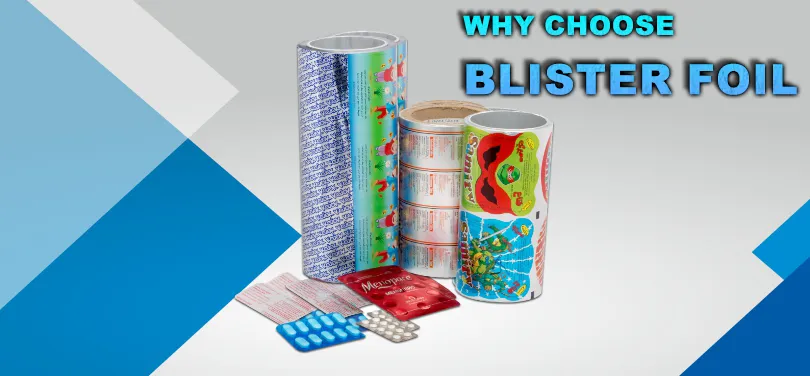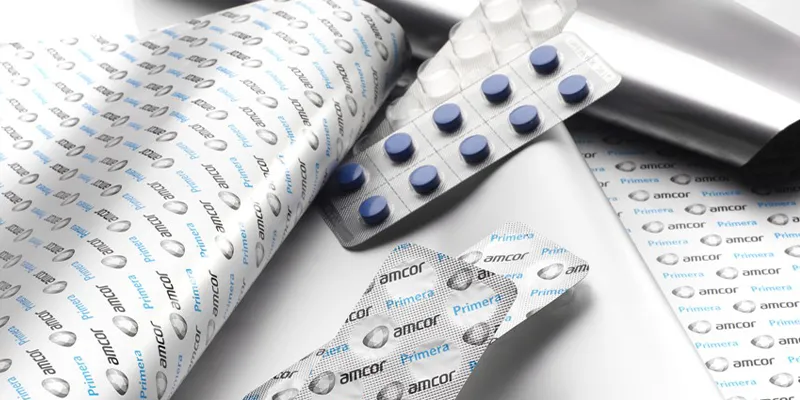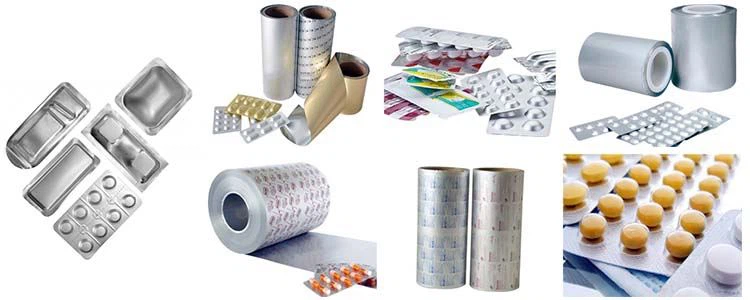Most of the medicines we see now are packed in boxes. When you open the box, you will see the tablets are packed with aluminum foil laminated PVC or PET. Some medicines will also wrap the entire shell with aluminum foil, such as blisters. So, why choose aluminum foil to package medicines?

This article will introduce you to the role of blister foil in protecting the quality of medicines.
What Is Blister Foil
Blister foil is a key component of blister packaging, which is usually composed of a layer of aluminum foil. Blister foil is often laminated with a plastic or paper backing to seal tablets and capsules in blister packaging. Blister foil is a secure seal and can prevent contamination.
As a special kind of pharmaceutical aluminum foil, blister foil has requirements for purity, thickness, surface quality, characteristics, and heat-sealing properties compared with ordinary aluminum foil. The specific standards are as follows:
| Standard Name | Details |
| Purity | The purity of pharmaceutical blister packaging foil should meet the standard purity requirements, such as aluminum content not less than 99.5%, iron content not more than 0.25%, and silicon content not more than 0.4%. |
| Thickness | The thickness of blister foil is generally 0.020 mm to 0.045 mm. Internationally, the European Pharmacopoeia stipulates that the thickness of aluminum foil is generally 0.020 mm to 0.060 mm, while the United States Pharmacopoeia stipulates a narrower range of 0.020 mm to 0.025 mm. |
| Surface | The surface of pharmaceutical aluminum foil should be flat and smooth, without obvious scratches, dents, or oxidation spots. The surface flatness generally does not exceed 0.005 mm, and the surface finish is not less than Ra 0.6. |
| Corrosion Resistance | Pharmaceutical aluminum foil should have good corrosion resistance to avoid harmful chemical reactions when in contact with drugs. Specific requirements include that the reaction with acidic and alkaline drugs should not produce abnormal odor or color changes and should not dissolve in drugs. |
| Hygroscopicity | The moisture absorption rate of medicinal aluminum foil should generally not exceed 0.5% to avoid adverse effects on the quality and stability of the medicine. |
| Antibacterial Ability | Blister aluminum foil should have good antibacterial ability to ensure the sterility of the drug. The standard requires that the total bacterial count should not exceed 10 CFU/g and should not contain microorganisms from the external environment. |
| Heat Seal | Good heat seal can prevent drugs from being contaminated and damaged by the external environment during storage and transportation. The seal strength should be greater than 12 N/15 mm so that the aluminum foil bag of the drug will not break or leak when subjected to a certain external force. |
| Heat Resistance | Medicinal foil should have good heat resistance and be able to withstand high temperature sterilization and other treatment processes. At the same time, its moisture retention performance is also very important, which can prevent the volatilization and absorption of water in the medicine and ensure the quality and stability of the medicine. |
Why Use Aluminum Foil Foil Blister Packaging
Excellent Barrier Properties
- Moisture-proof and moisture-proof: Aluminum foil is a waterproof material that can prevent drugs from being damaged by moisture and humidity. This is especially important for many drugs that are susceptible to moisture, such as capsules, effervescent tablets, film-coated tablets, etc. Once they are exposed to moisture, the efficacy of the drug will be reduced, and they may even deteriorate and mold.
- Anti-oxidation: Aluminum foil packaging can reduce oxygen contact, thereby reducing the risk of drug oxidation. By isolating oxygen to slow down the oxidation rate of drugs, such as vitamin C tablets, coenzyme Q10 and other easily oxidized drugs, they can be stored in this way.
- Light-proof: Aluminum foil also has good light-shielding properties, which can protect light-sensitive drugs from being damaged by ultraviolet rays. For example, drugs such as nifedipine tablets and chlorpromazine hydrochloride tablets that need to be stored in a cool place can be packaged in aluminum foil to ensure that they are not affected by light during storage.
Protect Drug Quality
- Extend shelf life: Aluminum foil packaging can delay the interaction between drugs and the external environment, thereby extending the shelf life of drugs.
- Maintain active ingredients: Aluminum foil packaging maintains the active ingredients and efficacy of drugs, preventing them from decomposing or deteriorating during storage.

Easy To Use
- Easy to produce and disassemble: Aluminum foil has good calendering properties and is easy to produce and disassemble. When taking medicine, patients can easily tear open the aluminum foil package to take out the tablets.
- Humanized design: The aluminum foil medicine board adopts a humanized design, such as the design with a groove in the middle to prevent the tablets from being crushed and at the same time facilitate patients to divide and count medicines.
Safety And Hygiene
- Antibacterial: The surface of aluminum foil is relatively smooth and is not easy to carry bacteria.
- Anti-counterfeiting: Aluminum foil packaging can also be used for anti-counterfeiting packaging, ensuring the authenticity and safety of drugs through specific printing technology and logos.
Good Printability
- Beayty: Medical aluminum foil has good printability, and text or patterns of various colors can be printed on both the glossy and dark sides of the foil.
Blister Foil Material Composition And Types
Blister Foil Composition
Aluminum foil: Aluminum foil is the most important part of blister foil and is usually used as the inner layer material. It has excellent moisture-proof, light-proof and anti-oxidation properties.
Polyester: Blister aluminum foil is often laminated with polyester materials, such as AL/PVC, AL/PVDC, AL/PET. AL/PVC is often used in ordinary blister packaging, which is easy to form and has low cost. AL/PVDC has stronger barrier properties and is suitable for products with high moisture resistance. AL/PET is transparent and strong, and has good printability.
Paper: Some blister packaging is also laminated with paper, which can enhance the packaging strength and prevent the aluminum foil or plastic from tearing.

Blister Foil Types
- Traditional blister packaging is made of polyester material and aluminum foil. This type is widely used for tablets, capsules, candies, and chocolate packaging.
- Thermoformed blister packaging is a packaging method that heats plastic sheets to a certain temperature to form blisters in a mold. Aluminum foil or plastic film will be heat-sealed on the blister. Commonly used in pharmaceutical packaging: for example, putting a single tablet or capsule into a small blister.
- Cold-formed blister packaging is a packaging method that is formed without heating and is usually made of PVC material. This packaging method has good transparency. Common cosmetics in English: such as individually packaged facial masks, lipsticks, etc.


